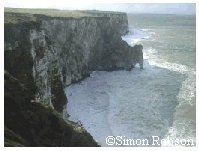 |
 |
The Flamborough Lifeboats |
 |
 |
© Simon Robson
1998-2007
Home
Services
Boats..
Pictures
R.N.L.I
Links
History..
Awards..
Rescue of 2 men & a dog - 22nd September 1971
This page was |
Misc. |
| Site Map Copyright |
Awards |
Chairmans Letter |
The seventh medal was won during the Flamborough Lifeboat Centenary year of 1971. This was won by Coxswain George R. Pockley.
On the 22nd September at around 7.50pm a report was received that a small boat had been spotted drifting close the cliffs at a place know locally as Staple Newk. It appeared to be un-manned and close inshore. The maroons were fired and the lifeboat "Friendly Forester' was afloat five minutes later at 8.05pm. The wind was east south easterly, strength 2 to 3 with a moderate swell. The weather was hazy with moderate to poor visibility.
Coxswain Pockley ran the lifeboat northward across the tide line to cover the possibility of survivors being still in the water. The Coastguard mobile patrol unit had gone to the cliff top and was lighting the area with white parachute flares in the meantime. The lifeboat crew spotted a flashing light under the cliff at Staple Newk at around 8.20pm. The lifeboat was brought tight inshore. The load hailer was used to ask the people onshore to wave their light if they required assistance. The light began waving frantically.
 The lifeboat was then informed by the Coastguard that a group of three men and a dog had set off from Filey in a small boat powered by an outboard motor and towing a small pram dinghy. Two of the group had attempted to land using this pram dinghy but it had capsized in the dumping swell and been washed away. The third member of the group realising their predicament had returned to Filey to raise the alarm.
The lifeboat was then informed by the Coastguard that a group of three men and a dog had set off from Filey in a small boat powered by an outboard motor and towing a small pram dinghy. Two of the group had attempted to land using this pram dinghy but it had capsized in the dumping swell and been washed away. The third member of the group realising their predicament had returned to Filey to raise the alarm.
The best way to rescued the pair and their dog would have been from the cliff top. Unfortunately, the cliff at that point was some 300 feet high, overhanging and with unstable soft clay on the top. The Coxswain knowing this radioed the Coastguard that he would attempt a rescue from the seaward side. The lifeboat was brought head to sea and the anchor was deployed. The lifeboat was then veered back in a westerly direction into a narrow channel between hidden rocks. It was difficult the hold the lifeboat in this position as the ebb tide had begun and was running south to north across the channel. The Coxswain then veered in a southerly direction. A grapnel line was then deployed and used to keep the boat into the tide.
The echo sounder was frequently showing zero as the lifeboat rose and fell in the broken seas. It was showing a wave height of over ten feet. The lifeboat was veered back as far as the shallow water would allow. The crew then fired a line ashore to the two stranded men, who by now were taking shelter in the mouth of a small cave. By now it was dark and the first two lines were lost as the men were unable to locate them. The third line was aimed straight into the cave and achieved the desired result. There was no fixed point ashore to attach the block to, so the breeches buoy was sent ashore with two veering lines a fixed to it.
With the lifeboat holding position, crewman Alwyn Emmerson swam ashore in the breeches buoy, through confused and broken waters. The first casualty was hauled back through the water to the lifeboat wearing a life jacket brought by Mr Emmerson. The breeches buoy and life jacket were then pulled back to shore. The second casualty repeated the process, but he also carried his dog with him. Finally Mr Emmerson was pulled back to the safety of the lifeboat. When all were aboard the lifeboat manoeuvred her way out of danger dropping the grapnel line as they went. The lifeboat and casualties were back on station by 10.10pm.
The Royal National Lifeboat Institutions Committee of Management awarded a bronze medal for gallantry to Coxswain George R. Pockley and recorded its thanks inscribed on vellum to Mr. Emmerson. The other crew members: James Major, R. Major, A. Cory, J. Crossland and John Major were presented with medal service certificates. The ceremony was carried out at Flamborough by Lord Halifax the Lord Lieutenant of the East Riding of Yorkshire. Pictures of the ceremony can still be seen on the lifeboat house wall at South Landing. The other crew members were presented with retrospective bronze medals by the Royal National Lifeboat Institution in November 1998.

Designed by Simon Robson ©1998-2007
Helmsman - Flamborough Lifeboat Station